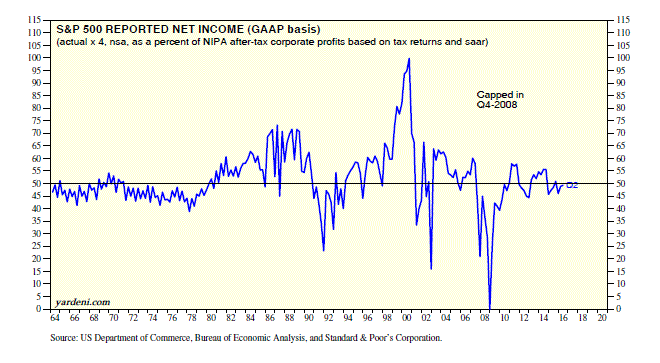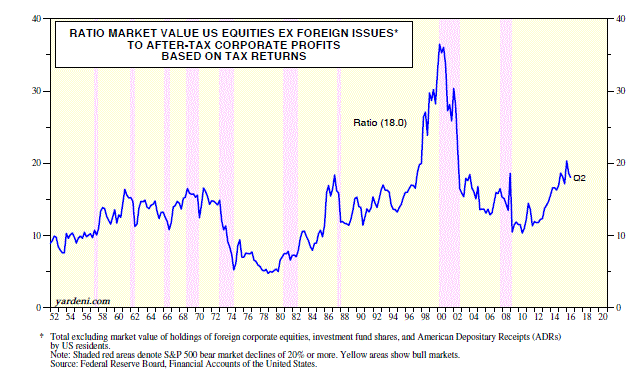
Last week, in his 10/5 WSJ “Heard on the Street” column, Justin Lahart had a closer look at the “cyclically adjusted price-earnings,” or CAPE, ratio developed by Robert Shiller and John Campbell in the 1990s. Shiller became a superstar in our business when he argued in his 2000 book titled Irrational Exuberance that his ratio, which is based on 10-year trailing earnings, was signaling irrational exuberance just as stocks started to plunge. Then again, just about every other valuation metric on the planet was sending the same signal. In any event, the ratio is signaling trouble again.
Previously, I’ve described judging valuation as similar to judging contestants in a beauty contest. Both are subjective judgments. Valuation judgments can be quite different depending on the metrics used to make a determination. There are lots of alternative options. I look at them all.
I am not a fan of valuation measures based on trailing earnings, especially if they trail over the past 10 years. I believe that the stock market is forward looking and discounts analysts’ consensus expectations for earnings over the year ahead. More specifically, I use S&P 500 12-month forward consensus expected operating earnings, which is a time-weighted average of analysts’ expectations for the current year and the coming one. While the forward P/E of the S&P 500 isn’t as alarming as Shiller’s CAPE ratio, stocks aren’t cheap using almost any valuation metric other than the Fed’s Stock Valuation Model, which has been showing that stocks have been increasingly undervalued relative to bonds since 2001. (See our new and improved FSVM.)
In his column, Lahart often provides excellent analyses of the stock market. In his latest piece, he observed that:
[CAPE’s] advantage is that it corrects for extreme good times and bad times by valuing share prices based on 10 years of earnings, rather than one year. … The CAPE is now at 27. That is about where it was in 2007, before the financial crisis, and it is well above its 50-year average of 20. The only times the CAPE has been higher were during the 2000 bubble and bust, and just prior to the 1929 crash, according [to] the data compiled by Mr. Shiller. (Hence, the title of this piece, which is also a play on the 1962 movie “Cape Fear” with Robert Mitchum and the 1991 remake with Robert De Niro.) Let’s have a closer look:
(1) Measuring earnings. Lahart reported:
Mr. Shiller uses S&P 500 earnings under generally accepted accounting principles, or GAAP. That is probably the best measure of earnings because it avoids many of the tricks that companies use to flatter their numbers. The problem is that GAAP isn’t a stable concept, and has been revised multiple times. In 1993, for example, banks were required to mark to market a greater portion of their holdings. In 2001, accounting rule makers changed the rules on goodwill. Wharton Professor Jeremy Siegel says that both changes lowered GAAP earnings.
The WSJ constructed an alternative CAPE ratio using quarterly data on total after-tax US profits from the National Income & Product Accounts (NIPA) accounts, presumably because this measure is compiled using “a consistent standard over the decades.” I compared aggregate S&P 500 reported earnings, which is the GAAP measure, to the NIPA after-tax corporate profits based on tax returns. The former is annualized but not seasonally adjusted, while the latter is both annualized and seasonally adjusted. I compared them since Q1-1964, when the S&P data start.
When I take the ratio of the S&P measure to the NIPA measure of profits, I don’t see the impact of the accounting changes mentioned above. The ratio has been volatile but has fluctuated around 50% without any pronounced structural shifts along the way since the start of the comparison.
(2) CAPE of good hope. Next, the WSJ analysis used Fed data on the total value of US stocks rather than the value of the S&P 500. I prefer to use the same measure excluding foreign equities trading in the US when we use these data for the comparable valuation measures we construct. Foreign equites held by US residents as a percentage of their total equity holdings was relatively flat around just 1% from 1952 through the mid-1980s. Then it soared to peak at 21.1% during Q2-2008. It has been hovering around 20% since then. Foreign equities should be excluded from the numerator of the ratio, because their profits are not included in the NIPA profits.
The WSJ measure of the CAPE ratio is less fearsome than Shiller’s version:
As of the end of the second quarter, according to the latest data available, the corporate-profits CAPE was at about 19--just above its 50-year average of around 17. By contrast, it was 39 at its peak during the tech bubble and 24 at the market’s peak in 2007. That’s a relief. It would be even lower using the total value of equities traded in the US excluding foreign issues.
(3) Short trail. I can’t bring myself to compare the value of the stock market today to earnings over the past 10 years. Instead, let’s look at my ratio of the value of equities excluding foreign issues divided by the NIPA profits measure on a quarterly basis rather than on a 40-quarter trailing basis. During Q2-2016, it was 18.0. The record high was 36.5 during Q1-2000, while the record low was 4.7 during Q4-1978. Its current reading does match previous cycle highs excluding the irrational exuberance peak of Q1-2000.
Given that inflation and interest rates are lower than at any time since we can calculate this ratio, it seems to suggest that stocks are fairly valued rather than seriously overvalued. That’s about the same conclusion that Lahart came to with his version of the 10-year trailing CAPE ratio.
(4) Tobin & Buffett ratios. The CAPE ratio certainly isn’t a novel measure of valuation. It is highly correlated with the Q ratio devised by Professors James Tobin and William Brainard in 1968 at Yale University. The concept is simple: It is the ratio between a physical asset’s market value and its replacement cost. When applied to the overall stock market, a ratio exceeding 1.0 suggests stocks are overvalued, while a ratio below 1.0 suggests they are undervalued.
Measuring that ratio seems like a huge challenge. However, the Fed’s Financial Accounts of the United States has a quarterly series starting in 1952 that tracks Tobin’s Q for nonfinancial corporations. It is highly correlated with the ratio I constructed inspired by Lahart and Shiller, though mine is based on quarterly profits rather than 10-year trailing profits.
My ratio is also highly correlated with the Buffett ratio, which is the market value of US equities excluding foreign issues relative to GNP. I’ve found that the Buffett ratio is also highly correlated with the ratio of the market capitalization of the S&P 500 divided by S&P 500 revenues. I can get a more real-time read on these simply by tracking the S&P 500’s forward price-to-sales ratio.
(5) Looking forward. The S&P 500’s forward P/E (based on forward operating earnings) was 16.6 during September. That isn’t much higher than its 13.8 average since 1979, when the data begin. However, that’s well below Q2’s 21.1 P/E based on four-quarter trailing operating earnings, and 23.9 based on four-quarter reported earnings.
Had enough yet? On balance the most widely followed valuation measures all show that the market is somewhere between fairly valued and overvalued. However, bear markets are caused by recessions, not overvaluation. Recessions cause earnings to fall, which causes stock prices to fall even faster, thus depressing valuations. In my opinion, the stock market can remain overvalued as long as earnings continue to grow. That’s particularly likely now given that both inflation and interest rates are at historical lows.
Meanwhile, S&P 500 forward earnings rose to a record high during the first week of October. The same can be said for the S&P 600, while the S&P 400 edged down from its record high two weeks ago.

